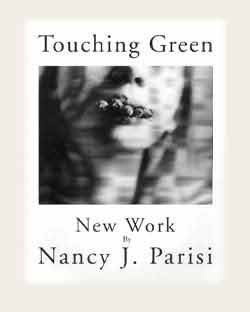The Call of the Wild: Nancy Parisi's Still Lifes
Nancy Parisi's photographs are rich in human interest and visual contrast, whether the shot is of a smiling local politician, Mick Jagger in mid-howl, or a formally composed study of a hand holding a piece of fruit. They are a familiar sight in Western New York, from the pages of our local publications to group exhibitions in area galleries.
What audiences familiar with her photography might not know is that Nancy Parisi is also a writer who has been publishing poetry and non-fiction prose for over 15 years. During the '80s, as an English major at the University at Buffalo, I became aware of Parisi's poetry while reading the Alternative Press, a now-defunct UB student newspaper. Like her photographs, her poetry is unexpected, sensual, and seamlessly composed. In early poems like "Passionave," Parisi hints at transgressions, never crude, but intimate and disturbing:
Was seduced the other day
by accident.
Let another fondle
my mind and then
told them my secrets(from "Passionave," 1981)
It did not surprise me when she told me that her ideas for the still lifes came out of her writing. In most of the still lifes, a small human hand is variously draped with flora or fauna, a type of confrontation where the juxtaposed elements become stand-ins for our sexual drive, our need to consume things helpless to resist us, and our general craving to indulge our bodies--three strains of desire that become inextricably entangled in many of our daily activities, regardless of how we may gild them in an armature of civilized professional behavior. This is not to say that Parisi's work is some illustrated Freudian parable. Rather, just as a poet makes strong, economical juxtapositions with language, the artist chooses visual imagery that will have an immediate impact, accessible to many interpretations. In this sense, Parisi's imagery can be called archetypal. She attempts to make vivid and spontaneous essential questions that are never adequately answered in so-called "rational" discourse, questions like "what is human/animal?", "what is male/female?", and "what is permissible/taboo?"

In Parisi's hand and non-hand works made during the last year, the juxtapositions have become more sexually charged, more illustrative of power relationships. Fist and Rose, for example, features a closed fist (in earlier works, the hands are limpidly passive) clutching a rosebud, the flower's opening visible between the encircling fingers. In Hand and Protea, a carnivorous-looking plant threatens to engulf the hand, while in Hand and Skate Eggs, the villainous black egg cases seem ready to leap off the fingers and burst into life before our eyes. Other works--like Stem Mouth and Rose Lips--are even more direct, using the expressive possibilities of the human face to further dramatize the primal issues inherent in the photographs. Most recently, she has completed a series of color photographs which concentrate solely on organic and inorganic objects, leaving out the human element. Usually, in each, one of the forms takes on the aggressive persona where the other is more acted upon.
What keeps Parisi's work from acquiring a creepy, Little Shop of Horrors overcast is the technical meticulousness of her technique and the healthy exuberance of the imagery. Parisi expresses her pleasure in the beauty of life through her art, at the same time acknowledging the ambivalent and/or threatening aspects of that beauty. It might sound corny, but many other artists--historical and postmodern--have done the same, from Caravaggio to Clemente.
It's not hard to find the same working aesthetic in Parisi's other photography. Her What Has Happened series--photos and descriptions of local events published in the Buffalo weekly Artvoice--celebrates life in a more uncomplicated manner than the still lifes. Although they can be seen as a "who's who," the photographs (and their captions) are more than that. They tell a story of people coming out under all conditions (of schedules and weather) to take part in the abundance of culture their city has to offer, because they believe in it. Through holding up this weekly mirror to our activities, Parisi graphically demonstrates how much more there is to life than a paycheck and a mortgage. Her Industrial Film Strips, portraying sites of former industry in Buffalo and Niagara Falls, cut the immense factories, bridges, and warehouses down to human-level, taking an intensely personal view (tiny vignettes) that emphasize our relationship to these places, rather than their undeniable physical grandeur.
Parisi's incredibly busy and diverse working life has greatly enriched the content of each of her photographic explorations. Through combining a highly literate intellect, an idiosyncratic instinct, and an inventive and sophisticated visual aesthetic, she finds what we need to look at.
Big Orbit Gallery, 1999

